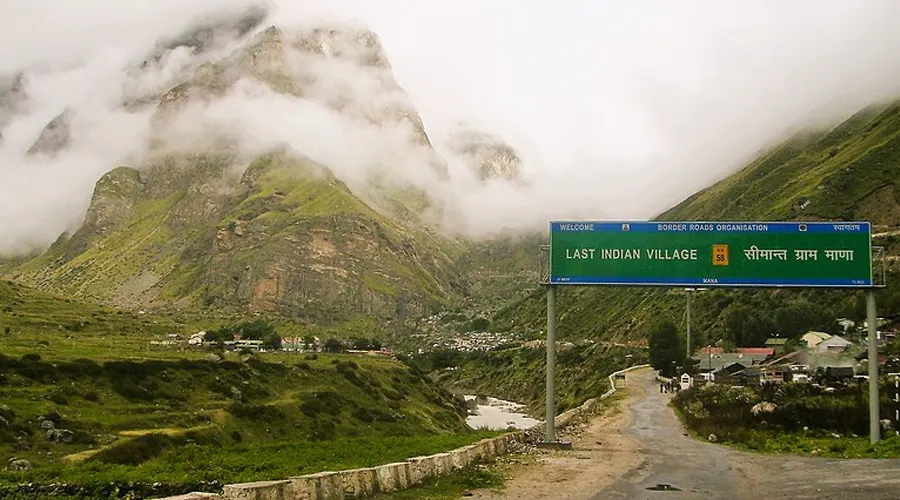MANA “The Last Village in India”
Mana village is no longer India’s Last Village as it was previously known. The Border Roads Organisation (BRO) has placed a signboard at the village of Mana, where it says “First Indian Village.”
Mana village was previously known as the Last Village of India due to its proximity to the Indo-Tibetan border.
Mana is known as the last village of India’ often make people confuse between Mana in Uttarakhand and Chitkul in Himachal Pradesh, as to which one of these holds the title of being ‘the last village in India’? Well, to make things clear, Chitkul is the last inhabited village located on the Indo-Tibet border, but Mana in Uttarakhand is officially recognized as the ‘last village of India’
Mana is the last Indian village situated in Chamoli district at an elevation of 3200 m in Uttarakhand. Mana village is on the banks of River Saraswati and is around 5 km from the famous Hindu pilgrimage center Badrinath. If you ever visit this beautiful village which is 24 km from the Indo-China border, making it the last village of India you will notice that the shopkeeper’s in the region selling their products using the title of ‘last village’ like ‘India’s Last Tea and Coffee Corner’, which is unique and interesting at the same time.
People who are living there are called Bhotias (Mongol tribes). The villagers of this village live in small cottages that are decorated and carved gracefully. Mana is also famous for its woolen garments and materials made up of sheep wool, like, shawls, caps, mufflers, ashan, pankhi (which is a thin blanket), carpet, etc.
Mana village holds a huge religious significance for the Hindus as the traces of The Mahabharata is visible here. It is believed that the Pandavas crossed the Mana village while making their final journey to heaven. The place also has a stone bridge called Bheem Pul near River Saraswati, which’s believed to be created by Bheema, one of the five Pandava brothers. It feels that once upon a Gods, indeed lived next door in this mystical village, in the Dev Bhoomi of Uttarakhand. It feels amazing to learn that the kids of Mana know the stories from the Mahabharata by heart.
Mana, though small in size, is quite big where popularity is concerned.
Here are some interesting facts about Mana Village:
- Mana Village is also known for its proximity to the holy shrine of Badrinath, which is located about 3 km from the village. The village is situated at an altitude of about 3,200 meters (10,500 feet) above sea level and is accessible by road. Many people visit Mana while on their pilgrimage to Badrinath.
- Mana Village is situated in a beautiful valley surrounded by towering snow-capped mountains. The village offers stunning views of the Himalayas and is a great place to relax and enjoy nature.
- Mana Village has a rich history and is believed to be one of the oldest inhabited villages in India.
- The village is believed to be the birthplace of the Pandavas.
- Since Mana Village is located near the Indo-Tibetan border, it is influenced by both Indian and Tibetan cultures. The village has a unique blend of architecture, food, and traditions, which attracts many tourists who are interested in experiencing the local culture.
Places to visit in Mana
Apart from Vyas Gufa and Ganesh Gufa, Mana village houses quite a few tourist attractions, some of which are absolute nature’s bliss, while some are straight out of mythology.
Neelkanth Peak
Set at an altitude of 6597 ft. above sea level, Neelkanth Peak is one of the utmost attractions in Mana Gaon. Also known as ‘Queen of Garhwal’, this snow-clad peak beautifully towers the Badrinath Temple and makes for a must-visit attraction for every adventure and trekking enthusiast.
Tapt Kund
As per Hindu mythology, Tapt Kund is the holy abode of Lord Agni or Fire God. This natural spring is believed to have medicinal properties, and people say that taking a dip in the ‘Kund’ water cures skin diseases.
Vasudhara
These picturesque waterfalls which lie just 9 km from Badrinath Temple give panoramic views. It is believed to have been home to the Pandavas for some time when they were in exile.
Vyas Gufa
The interesting thing about this cave is a small shrine which is dedicated to Ved Vyas, the renowned scholar and the writer of the epic, and it is believed to be more than 5000 years old. Ved Vyas used to live inside this cave while composing the famous four Vedas.
Bheema Pul
One of the prime attractions in Mana Village is Bheema Pul. There’s a natural stone bridge over the gushing river here and legend has it that when the Pandavas were crossing this river on the way to heaven, Bheema lifted a massive rock and placed it here to help his wife, Draupadi, cross the river. Right next to Bheem Pul you can also see a 20 ft. tall foot-shaped mark on the rock that is said to be the footprint of Bheema.
River Saraswati
The spiritual River Saraswati is named after the Goddess of wisdom on whose bank one of the greatest Indian epics – The Mahabharata was written. According to the myth, the bubbling sound of the river was disturbing Ved Vyas to focus on Mahabharta and hence he cursed the noisy river to disappear. Due to that, the river is known as Gupt Gamini or the Hidden River since it flows just about 100 meters from its origin and then merges into River Alaknanda at Keshav Prayag in Mana.
Mata Murti Temple
The Mata Murti Temple is dedicated to the mother of Lord Narayan. According to folklore, Mata Murti requested Lord Vishnu to take birth as her son. Lord Vishnu granted her this wish by taking birth in the form of a twin, Nar, and Narayan. Many tourists visit this temple during the annual fair, held in August.


Comments (0)